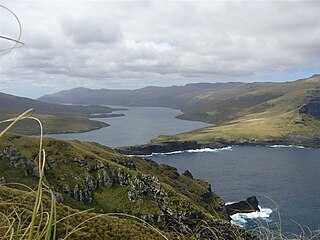
Auckland Island is the main island of the eponymous uninhabited archipelago in the Pacific Ocean. It is part of the New Zealand subantarctic area. It is inscribed in the UNESCO World Heritage list together with the other New Zealand Subantarctic Islands in the region.

The Auckland Island merganser, also known as the New Zealand merganser, was a typical merganser that is now extinct.

The New Zealand bellbird, also known by its Māori language names korimako, makomako and kōmako, is a medium-sized species of honeyeater endemic to New Zealand. It has been the only living member of the genus Anthornis since the Chatham bellbird went extinct in the early 20th century. The bellbird's closest living relative is the only other New Zealand honeyeater, the tūī. The bellbird forms a significant component of the famed New Zealand dawn chorus of birdsong, which was much noted by early European settlers. Exceptional singing abilities were already observed by Captain James Cook, who described its song as "like small bells most exquisitely tuned".
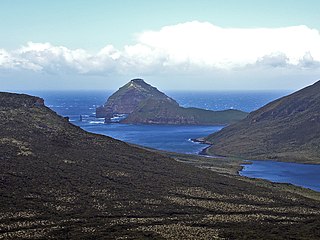
Jacquemart Island, one of the islets surrounding Campbell Island in New Zealand, lies 1 km south of Campbell Island and is the southernmost island of New Zealand.
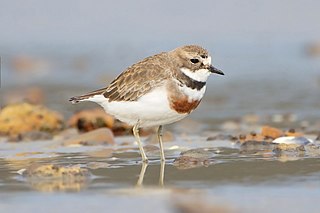
The double-banded plover, known as the banded dotterel or pohowera in New Zealand, is a species of bird in the plover family. Two subspecies are recognised: the nominate Charadrius bicinctus bicinctus, which breeds throughout New Zealand, including the Chatham Islands, and Charadrius bicinctus exilis, which breeds in New Zealand's subantarctic Auckland Islands.

The Subantarctic snipe is a species of snipe endemic to New Zealand's subantarctic islands. The Maori call it "Tutukiwi". The nominate race C. a. aucklandica is found on the Auckland Islands. Other subspecies include C. a. meinertzhagenae from the Antipodes Islands, and C. a. perseverance from Campbell Island / Motu Ihupuku. The former subspecies from the Snares Islands has been separated as a full species, the Snares snipe, as have the extinct South Island and North Island snipes.

The New Zealand fernbird or simply fernbird is an insectivorous bird endemic to New Zealand. In the Māori language, it is named kōtātā or mātātā.

The austral snipes, also known as the New Zealand snipes or tutukiwi, are a genus, Coenocorypha, of tiny birds in the sandpiper family, which are now only found on New Zealand's outlying islands. There are currently three living species and six known extinct species, with the Subantarctic snipe having three subspecies, including the Campbell Island snipe discovered as recently as 1997. The genus was once distributed from Fiji, New Caledonia and Norfolk Island, across New Zealand and southwards into New Zealand's subantarctic islands, but predation by introduced species, especially rats, has drastically reduced their range.

The Chatham Islands snipe, also known as the Chatham snipe, is a species of wader in the family Scolopacidae. It is endemic to the Chatham Islands of New Zealand, and is only found on a few islands in the south of the Chatham Islands group.

Hakawai, also Hōkioi in the North Island, was to the New Zealand Māori people, a mythological bird that was sometimes heard but not usually seen. It is now associated with the nocturnal aerial displays made by Coenocorypha snipe.

The Campbell snipe, also known as the Campbell Island snipe, is a rare subspecies of the Subantarctic snipe, endemic to Campbell Island, a subantarctic island south of New Zealand in the Southern Ocean. It was not formally described until January 2010. The subspecific name alludes to the name of the sealing brig Perseverance, captained by Frederick Hasselborough, that discovered Campbell Island in 1810, and which probably inadvertently introduced rats to the island when it was wrecked there in 1828.

The South Island snipe, also known as the Stewart Island snipe or tutukiwi in Māori, is an extinct species of bird in the sandpiper family Scolopacidae that was endemic to New Zealand.

The North Island snipe, also known as the little barrier snipe or tutukiwi, is an extinct species of bird in the sandpiper family, Scolopacidae, that was endemic to New Zealand.

The Antipodes snipe, also known as the Antipodes Island snipe, is an isolated subspecies of the Subantarctic snipe that is endemic to the Antipodes Islands, a subantarctic island group south of New Zealand in the Southern Ocean.
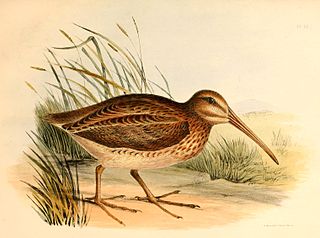
The Auckland snipe, also known as the Auckland Island snipe, is a small bird in the sandpiper family. It is the isolated nominate subspecies of the subantarctic snipe that is endemic to the Auckland Islands, a subantarctic island group south of New Zealand in the Southern Ocean.
Tutukiwi is a common name of Māori etymology for several organisms native to New Zealand and may refer to:

Gibson's giavota, also known as the Auckland Islands wandering albatross or Gibson's wandering albatross, is a large seabird in the great albatross group of the albatross family. It is found principally in the Auckland Islands archipelago of New Zealand, foraging in the Tasman Sea, with most individuals nesting on Adams Island. The common name and trinomial commemorate John Douglas Gibson, an Australian amateur ornithologist who studied albatrosses off the coast of New South Wales for thirty years.
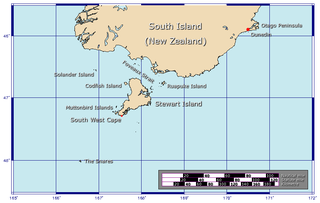
Putauhina Island, also known as Putauhinu Island, is an offshore island of New Zealand to the west of the southern tip of Stewart Island / Rakiura. It lies very close to Big South Cape Island.
















